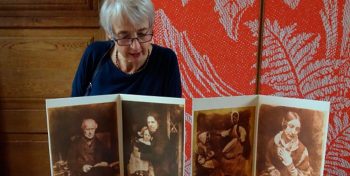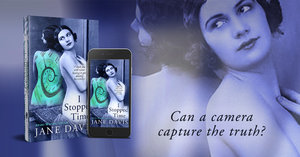Today, I’m delighted to welcome Ali Bacon to Virtual Book Club, my interview series which gives authors the opportunity to pitch their novels to your book club.
After graduating from St Andrews University, Ali worked in Oxford’s Bodleian Library where she found a cache of famous Victorian photographs, sparking a life-long interest in early photographers. In the Blink of an Eye follows her first novel, A Kettle of Fish (Thornberry 2012) and marries her passion for fiction and photography. Chapters from In the Blink of an Eye have already been successful in local and national short story competitions.
Ali lives near Bristol where she counteracts the sedentary occupation of writing with plenty of fresh air and exercise, usually on a golf course. She also helps run local writing events and sometimes acts as a short story judge.
In The Blink of an Eye by Ali Bacon is one of the gems I discovered from participating in Indieathon, a month-long readathon of fiction published by independent presses and authors. (I was lucky enough to receive an Advance Reader Copy, prior to its release on 11th April.) Not only does it touch on one of my favourite subjects, the pioneers of photography (I learned about a link between Robert Adamson and with William Henry Fox Talbot that I was previously unaware of), but Rock House, Edinburgh, one of the novel’s key settings, was familiar to me as I stayed there in the summer of 2016.
I was surprised to learn that this is Ali’s first venture into historical fiction. Today I’m asking her how she came to take this step and what difficulties she encountered.
But first, a little about the book
He had Edinburgh at his feet, but who would be by his side?
In 1843, Edinburgh artist David Octavius Hill is commissioned to paint the portraits of 400 ministers of the new Free Church. Only when he meets Robert Adamson, an early master of the new and fickle art of photography, does this daunting task begin to look feasible.
Hill is soon bewitched by the art of light and shade. He and Adamson become the darlings of Edinburgh society, immortalising people and places with their subtle and artistic images.
In the Blink of an Eye is a re-imagining of Hill’s life in the words of those who were beguiled by his artistry and charismatic charm. Tender, tragic and sometimes humorous, these voices come together in a story of art and science, love and loss, friendship and photography.

“Poignant and charged with hope” ~ Vanessa Gebbie, author and judge of Evesham Festival Short Story Prize 2017 (Chapter 3, The Bird of Wax)
“That moment of dawning self-consciousness, so delicately rendered, yet so resonant … just knocked my socks off” ~ Nick Bellorini, photography publisher and judge of Magic Oxygen Prize 2017 (Chapter 6, Silver Harvest)
“This is a wonderful book: well researched, beautifully written, original in execution and often deeply moving. I found it as magical and profound as the work of the people who inspired it.” ~ Catherine Czerkawska, author of The Jewel
What is the origin of your interest in D.O. Hill and why did you want to put him in a novel?
I stumbled on the Hill and Adamson story while writing my previous novel, A Kettle of Fish. I needed an art gallery location for a meeting between my heroine and her mother and not being much of an art buff I shied away from talking about, for instance, painting or sculpture. Then Google brought up a Scottish National Portrait Gallery exhibition featuring the *Hill and Adamson Newhaven calotypes and was immediately engaged on my heroine’s behalf (she had a passion for anything fishy) and my own. I’d always had an interest in early photography which I was happy (maybe too happy!) to renew. But what drew me to the story was the artist’s personal journey and the triumphs and tragedies it contained. The fact that he had links to places I knew and loved, including St Andrews, my alma mater and my home town of Dunfermline made the whole thing a labour of love.
Editor’s note: Do click on the link on the paragraph above, scroll down and watch the video to see why Ali was gripped by this story. You’ll see the backdrop to the novel, calotypes of Hill and Adamson and some of their work – fascinating!
So, you had a story ‘ready made’. Did that make the book easier to write than a complete fiction? And to what degree did you ‘fictionalise’ what you found?
Yes, at first I thought having a plot ready made was a gift, but it as a writer I’m a ‘pantser’. I work out the story as I write it. Until it falls into place, it’s an act of exploration. Crafting a novel from a ‘found’ story brought up difficulties of a different kind. I also assumed in the first place that I would ‘convert’ the original story into a conventional novel. To do this I looked for obvious conflicts – particularly amongst the many women characters – and I explored the use of a ‘fictional minor character’ to lead the narrative. However none of these strategies quite worked, and the more research I did the less I wanted to digress from ‘the facts’ – if we can ever call them that. The finished book has a few completely fictional characters who fill in vital (or interesting!) gaps in the historical narrative. Otherwise I’ve departed very little from what I know or believe to have happened.
Was research a joy or a bane?
Both! I loved digging around and finding things and spent a magical morning in the National Library of Scotland looking at some (largely indecipherable) letters of D.O. Hill. In the end I decided I am not a historian nor ever likely to be one, so I stuck to reputable secondary sources. I was also lucky enough to meet some great people who added to my knowledge and were generous with their help. Of course there was a point when I had to let go of the source material and let my imagination go to work.

How do you see the readership for this book?
I see it – as does Linen Press – as literary historical fiction, sitting alongside books like Tracy Chevalier’s Girl with a Pearl Earring or Jane Harris’ Gillespie and I. However, as a book which could be called ‘faction’, I’m hoping it will also appeal to people with an interest in photography whether or not they usually read fiction. Because it’s written in discrete episodes – some of which have won short story prizes – I think it’s also of interest to short story writers and readers.
Now the book is finished, do you think you will continue with historical fiction or revert to contemporary?
Hah, good question! In fact while working on Blink, I’ve been writing (contemporary) short stories which I sometimes perform at live events, which is for me a kind of light relief from working at the coal-face of a novel. Some of these might come together in a collection one day. Otherwise I haven’t really planned another major project but I admit I might have been bitten by the historical bug, so watch this space!
In the Blink of an Eye is available in paperback on per-order from Linen Press (£7.99 + P&P) or Amazon UK (£9.99 + P&P)
Want to find out more about Ali?
Visit her website
Remember, if you enjoyed this post please share it. If there’s anything else you’d like to ask Ali please leave a comment.
To have future posts delivered directly to your in-box, visit the sidebar on the right and subscribe to my blog, or to find out about new releases, competitions and freebies, subscribe to my newsletter and grab your free copy of my novel, I Stopped Time.




One comment
Congratulations! Ali, I’m picking up a copy for sure.